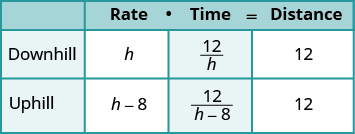| << Chapter < Page | Chapter >> Page > |
Dennis went cross-country skiing for 6 hours on Saturday. He skied 20 mile uphill and then 20 miles back downhill, returning to his starting point. His uphill speed was 5 mph slower than his downhill speed. What was Dennis’ speed going uphill and his speed going downhill?
Tony drove 4 hours to his home, driving 208 miles on the interstate and 40 miles on country roads. If he drove 15 mph faster on the interstate than on the country roads, what was his rate on the country roads?
Once again, we will use the uniform motion formula solved for the variable t .
Hamilton rode his bike downhill 12 miles on the river trail from his house to the ocean and then rode uphill to return home. His uphill speed was 8 miles per hour slower than his downhill speed. It took him 2 hours longer to get home than it took him to get to the ocean. Find Hamilton’s downhill speed.
This is a uniform motion situation. A diagram will help us visualize the situation.

We fill in the chart to organize the information.
| We are looking for Hamilton’s downhill speed. | Let Hamilton’s downhill speed. |
| His uphill speed is 8 miles per hour slower. Enter the rates into the chart. | Hamilton’s uphill speed |
| The distance is the same in both directions, 12 miles.
Since , we solve for t and get . We divide the distance by the rate in each row, and place the expression in the time column. |
 |
| Write a word sentence about the time. | He took 2 hours longer uphill than downhill. The uphill time is 2 more than the downhill time. |
| Translate the sentence to get the equation.
Solve. |
|
| Check. Is 12 mph a reasonable speed for biking downhill? Yes. | |
| Downhill | |
| Uphill | |
| The uphill time is 2 hours more than the downhill time. Hamilton’s downhill speed is 12 mph. |
Kayla rode her bike 75 miles home from college one weekend and then rode the bus back to college. It took her 2 hours less to ride back to college on the bus than it took her to ride home on her bike, and the average speed of the bus was 10 miles per hour faster than Kayla’s biking speed. Find Kayla’s biking speed.
Victoria jogs 12 miles to the park along a flat trail and then returns by jogging on an 18 mile hilly trail. She jogs 1 mile per hour slower on the hilly trail than on the flat trail, and her return trip takes her two hours longer. Find her rate of jogging on the flat trail.
Suppose Pete can paint a room in 10 hours. If he works at a steady pace, in 1 hour he would paint of the room. If Alicia would take 8 hours to paint the same room, then in 1 hour she would paint of the room. How long would it take Pete and Alicia to paint the room if they worked together (and didn’t interfere with each other’s progress)?
This is a typical ‘work’ application. There are three quantities involved here – the time it would take each of the two people to do the job alone and the time it would take for them to do the job together.

Notification Switch
Would you like to follow the 'Elementary algebra' conversation and receive update notifications?